fighterjetsworld
MEMBER
https://fighterjetsworld.com/2018/02/28/the-birth-of-the-golden-eagle/
A NEED
The Golden Eagle F-15C arises as a need to maintain an efficient vector that would supply the low number of stock that the F-22A Raptor has in the USAF.
With the cut of the planned total of the fleet of F-22A fighters, the officers of the USAF hope to be able to reinforce the muscles of the aerial domain by means of the F-15C Golden Eagle of the National Air Guard, updated with a modern avionics.
Due to the great autonomy and persistence in combat of the Boeing F-15, and the capabilities of its new radar, this fighter will also serve as a substitute for attack aircraft and electronic warfare as part of the USAF’s air force composite command. , which also includes the F-22A stealth fighters stationed at the Langley Air Base in Virginia.
NEW CAPACITIES
Each model will assume 50% of the air domain mission, more now that the F-22A force has been limited to a cap of 187 aircraft. The updated F-15C will carry the AESA AN / APG-63 (v) 3 radar. The large scope of this radar and its ability to detect small targets will allow the F-22 to operate in electronic silence without compromising its low observability (LO) with its own electronic emissions.
The Golden Eagle F-15C will also provide electronic and attack interference capability to protect the own strike force against enemy missiles and fighters, firing their missiles beyond the visual range (BVR), to complement the limited number of BVRAAMs ported by the F-22A, and using its radar to present the tactical situation to all other aircraft in the attack package.
The electronic monitoring capability of the modernized F-15C also allows to identify and precisely locate electronic transmitters – communications and radars in the air as well as on the ground – to direct conventional attack aircraft equipped with conventional missiles or cybernetic weapons, not Kinetic, or electronic. Examples of the latter are the Raytheon MALD-J (Miniature Air Launched Decoy-Jammer), the Champ (Counter-Electronics High-Power Microwave Advanced Missile Project) and the HPM generator (High-Power Microwave: High Power Microwave) for the cruise missiles being developed by Air Force Research Laboratory of the Kirtland Air Base.
The CFT resurfaces again in the Eagle community, now wanting to have a place in the Golden Eagle, the main advantage of the CFT or FAST Pack as they are known in the USAF is that they release the sub rails without taking the capacity of the fighter. fuel that 600-gallon tanks can carry, and that they can carry weapons in their structure. The disadvantage and very important, is the reduction of the maneuverability that the fighter possesses, the subalar tanks can be launched to give the fighter more maneuverability, the CFT can not be launched, that’s why it was never seen with a good eye its use in fighters air-air like the F-15C and F-15D.
Multiple launchers, these multiple launchers are very little known, the new multiple launchers grant a greater capacity of load of armament BVRAAM and WVRAAM extending of 8 missiles to 12 missiles or 16 if it adapts to the pillars of subalar tanks.
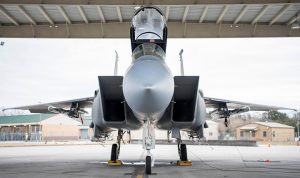
F-15C Golden Eagle with CFT
NEW AVIONICS
The Raytheon AN / APG-63 (v) 3 combines an active electronic scanning antenna with 1500 T / R, based on the one used in the AN / APG-79 radar of the F / A-18 Super Hornet Block II, with the proven radar software AESA AN / APG-63 (v) 2 with which team up to 18 F-15C Eagles that now serve in Alaska. Many of the components of the APG-63 (v) 1 mechanical antenna radar currently installed in most of the F-15C will be used, as it is feasible to use already proven radar components, the new AESA radar antennas It is 50 times more reliable than the mechanical scanning antenna it replaces. While it is one of the most recent radars developed by Raytheon, many of its features still remain undisclosed. Reportedly, AN / APG-63 (v) 3 gives the F-15C Golden Eagle the denomination of “F-22 for the poor”.
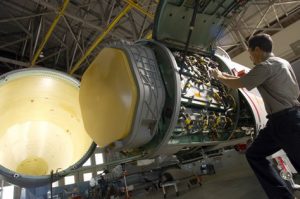
AN / APG-63 (v) 3
The new EPAWSS system replaces the obsolete TEWS, is designed to improve the effectiveness of the mission and the survival capability of the aircraft against existing and emerging threats. It offers geolocation solutions, situational awareness and self-protection to detect and overcome threats on the surface and in the air in high-density and highly controversial environments.
The ADCP II (Advanced Display Core Processor II) is capable of processing 87 billion instructions per second of computer performance, which translates into a faster and more reliable mission processing capability for the pilot. The system can simultaneously track multiple targets and provide highly effective air-to-air guidance capability, even when encountering advanced threats equipped with jamming technology.
The new Talon HATE system consists of a mountable capsule under the belly of the aircraft, which houses MILD / JTIDS Link 16 communication devices, SATCOM, passive detection devices such as the IRST21. The Talon HATE will be the most important of the new accessories of the Golden Eagle, because it allows to communicate with the F-22A, since they can not transmit in Link-16 because it can detect its broadcast location, basically through Data-Link 16 an F-22A can see what an F-15C sees, but not vice versa. What the Talon HATE does is to mask the Golden Eagle as if it were a Raptor, and in that way they share data in the Raptor’s own MIDS.
PASSIVE IR DETECTION SYSTEMS
The Pod Legion Pod consists of Lockheed Martin’s IRST21 developed from AN / AAS-42, the system operates by detecting infrared emissions from heat sources, such as aircraft or missile engines, and allowing the aircraft to passively detect other aircraft in the area that do not want to turn on their radars, this allows to see any threat without the need to emit RF.
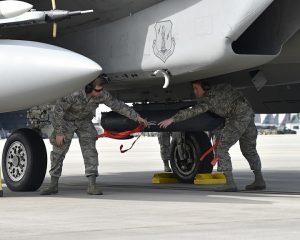
USAF’s personal riding the Sniper-XR
The AN / AAQ-33 Sniper-XR is capable of detecting targets through IR or FLIR images, being able to geolocate them with great precision and give a clear image of the tracked target, it is much more accurate than the AN / AAQ-14 of the LANTIRN system.
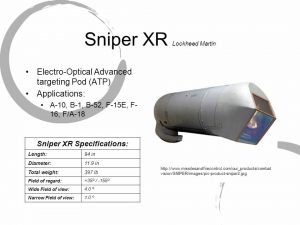 AN / AAQ-33 Sniper-XR
AN / AAQ-33 Sniper-XR
The tactical advantage given by the Sniper-XR system against the Legion Pod or the IRST21 of Talon HATE is that it allows the pilot to operate in the night environment using the FLIR image presented in the JHMCS of the pilot, but with much limitation with respect to the vision above the fighter, for the simple fact that the structure of the fighter obstructs the vision of the device.
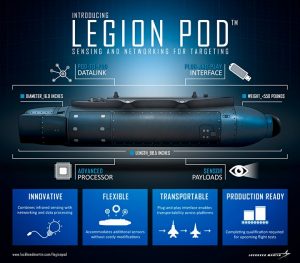
Legion Pod
MAIN THREATS
The main threats to the future would be the modern Su-35S Flanker-E at the service of the RuAF, and the future J-10B Vigorous Dragon of the PLAAF, the latter promises an advanced AESA radar that has not yet been finalized and continues as the main radar. Type 1473H, however the Su-35S is a breakthrough in technology compared to all aircraft in service of the USAF, including the Raptor, but with new technologies in the 2040 package from which the Golden Eagle leaves, allows the F-15C Overcoming the capabilities of the Eastern Dragon and approaching the capabilities imposed by the last Flanker, without lateral radars, or TWPR (Tail Warning Passive Radar) the F-15C Golden Eagle must eliminate these shortcomings with the combination of the different systems IRST / FLIR available, the new AESA radar that surpasses the AN / APG-79 and AN / APG-82,but once again without exceeding the AN / APG-77 (v) 1 of the F-22A.
The only problem with the F-15C and not less important is its huge RCS nominal battlefield, from 15m ^ 2 to 25m ^ 2 (the first in clean configuration and the second full loadout) since the Golden Eagle was not coated with RAM paint, parts were not replaced with composite materials, a huge deficiency that will cost a lot in terms of radar early detection, relying on the new capabilities of the EW (Electronic Warfare) system of the EPAWSS (Eagle Passive / Active Warning Survivability System).
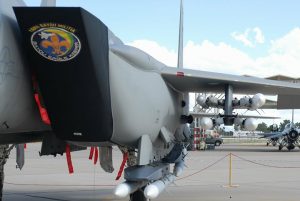
A NEED
The Golden Eagle F-15C arises as a need to maintain an efficient vector that would supply the low number of stock that the F-22A Raptor has in the USAF.
With the cut of the planned total of the fleet of F-22A fighters, the officers of the USAF hope to be able to reinforce the muscles of the aerial domain by means of the F-15C Golden Eagle of the National Air Guard, updated with a modern avionics.
Due to the great autonomy and persistence in combat of the Boeing F-15, and the capabilities of its new radar, this fighter will also serve as a substitute for attack aircraft and electronic warfare as part of the USAF’s air force composite command. , which also includes the F-22A stealth fighters stationed at the Langley Air Base in Virginia.
NEW CAPACITIES
Each model will assume 50% of the air domain mission, more now that the F-22A force has been limited to a cap of 187 aircraft. The updated F-15C will carry the AESA AN / APG-63 (v) 3 radar. The large scope of this radar and its ability to detect small targets will allow the F-22 to operate in electronic silence without compromising its low observability (LO) with its own electronic emissions.
The Golden Eagle F-15C will also provide electronic and attack interference capability to protect the own strike force against enemy missiles and fighters, firing their missiles beyond the visual range (BVR), to complement the limited number of BVRAAMs ported by the F-22A, and using its radar to present the tactical situation to all other aircraft in the attack package.
The electronic monitoring capability of the modernized F-15C also allows to identify and precisely locate electronic transmitters – communications and radars in the air as well as on the ground – to direct conventional attack aircraft equipped with conventional missiles or cybernetic weapons, not Kinetic, or electronic. Examples of the latter are the Raytheon MALD-J (Miniature Air Launched Decoy-Jammer), the Champ (Counter-Electronics High-Power Microwave Advanced Missile Project) and the HPM generator (High-Power Microwave: High Power Microwave) for the cruise missiles being developed by Air Force Research Laboratory of the Kirtland Air Base.
The CFT resurfaces again in the Eagle community, now wanting to have a place in the Golden Eagle, the main advantage of the CFT or FAST Pack as they are known in the USAF is that they release the sub rails without taking the capacity of the fighter. fuel that 600-gallon tanks can carry, and that they can carry weapons in their structure. The disadvantage and very important, is the reduction of the maneuverability that the fighter possesses, the subalar tanks can be launched to give the fighter more maneuverability, the CFT can not be launched, that’s why it was never seen with a good eye its use in fighters air-air like the F-15C and F-15D.
Multiple launchers, these multiple launchers are very little known, the new multiple launchers grant a greater capacity of load of armament BVRAAM and WVRAAM extending of 8 missiles to 12 missiles or 16 if it adapts to the pillars of subalar tanks.

F-15C Golden Eagle with CFT
NEW AVIONICS
The Raytheon AN / APG-63 (v) 3 combines an active electronic scanning antenna with 1500 T / R, based on the one used in the AN / APG-79 radar of the F / A-18 Super Hornet Block II, with the proven radar software AESA AN / APG-63 (v) 2 with which team up to 18 F-15C Eagles that now serve in Alaska. Many of the components of the APG-63 (v) 1 mechanical antenna radar currently installed in most of the F-15C will be used, as it is feasible to use already proven radar components, the new AESA radar antennas It is 50 times more reliable than the mechanical scanning antenna it replaces. While it is one of the most recent radars developed by Raytheon, many of its features still remain undisclosed. Reportedly, AN / APG-63 (v) 3 gives the F-15C Golden Eagle the denomination of “F-22 for the poor”.

AN / APG-63 (v) 3
The new EPAWSS system replaces the obsolete TEWS, is designed to improve the effectiveness of the mission and the survival capability of the aircraft against existing and emerging threats. It offers geolocation solutions, situational awareness and self-protection to detect and overcome threats on the surface and in the air in high-density and highly controversial environments.
The ADCP II (Advanced Display Core Processor II) is capable of processing 87 billion instructions per second of computer performance, which translates into a faster and more reliable mission processing capability for the pilot. The system can simultaneously track multiple targets and provide highly effective air-to-air guidance capability, even when encountering advanced threats equipped with jamming technology.
The new Talon HATE system consists of a mountable capsule under the belly of the aircraft, which houses MILD / JTIDS Link 16 communication devices, SATCOM, passive detection devices such as the IRST21. The Talon HATE will be the most important of the new accessories of the Golden Eagle, because it allows to communicate with the F-22A, since they can not transmit in Link-16 because it can detect its broadcast location, basically through Data-Link 16 an F-22A can see what an F-15C sees, but not vice versa. What the Talon HATE does is to mask the Golden Eagle as if it were a Raptor, and in that way they share data in the Raptor’s own MIDS.
PASSIVE IR DETECTION SYSTEMS
The Pod Legion Pod consists of Lockheed Martin’s IRST21 developed from AN / AAS-42, the system operates by detecting infrared emissions from heat sources, such as aircraft or missile engines, and allowing the aircraft to passively detect other aircraft in the area that do not want to turn on their radars, this allows to see any threat without the need to emit RF.

USAF’s personal riding the Sniper-XR
The AN / AAQ-33 Sniper-XR is capable of detecting targets through IR or FLIR images, being able to geolocate them with great precision and give a clear image of the tracked target, it is much more accurate than the AN / AAQ-14 of the LANTIRN system.

The tactical advantage given by the Sniper-XR system against the Legion Pod or the IRST21 of Talon HATE is that it allows the pilot to operate in the night environment using the FLIR image presented in the JHMCS of the pilot, but with much limitation with respect to the vision above the fighter, for the simple fact that the structure of the fighter obstructs the vision of the device.

Legion Pod
MAIN THREATS
The main threats to the future would be the modern Su-35S Flanker-E at the service of the RuAF, and the future J-10B Vigorous Dragon of the PLAAF, the latter promises an advanced AESA radar that has not yet been finalized and continues as the main radar. Type 1473H, however the Su-35S is a breakthrough in technology compared to all aircraft in service of the USAF, including the Raptor, but with new technologies in the 2040 package from which the Golden Eagle leaves, allows the F-15C Overcoming the capabilities of the Eastern Dragon and approaching the capabilities imposed by the last Flanker, without lateral radars, or TWPR (Tail Warning Passive Radar) the F-15C Golden Eagle must eliminate these shortcomings with the combination of the different systems IRST / FLIR available, the new AESA radar that surpasses the AN / APG-79 and AN / APG-82,but once again without exceeding the AN / APG-77 (v) 1 of the F-22A.
The only problem with the F-15C and not less important is its huge RCS nominal battlefield, from 15m ^ 2 to 25m ^ 2 (the first in clean configuration and the second full loadout) since the Golden Eagle was not coated with RAM paint, parts were not replaced with composite materials, a huge deficiency that will cost a lot in terms of radar early detection, relying on the new capabilities of the EW (Electronic Warfare) system of the EPAWSS (Eagle Passive / Active Warning Survivability System).

